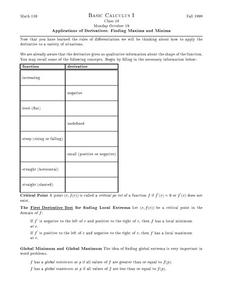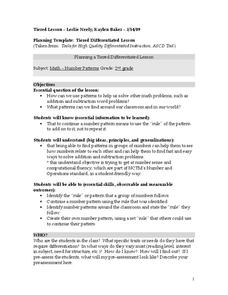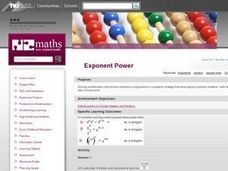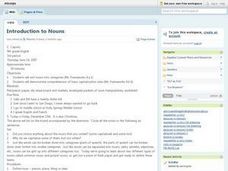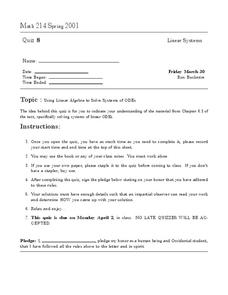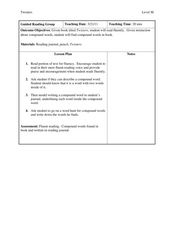College Board
2011 AP® Calculus BC Free-Response Questions Form B
Take a second look. Form B of the AP® Calculus BC free-response questions allow pupils and teachers to see another set of items. The six questions expand the set of items from the 2011 free-response questions. Form B items include a...
College Board
2008 AP® Calculus BC Free-Response Questions Form B
This is integral to the test. Pupils realize that every question in the released free-response items from the 2008 AP® Calculus exam Form B requires integration. By reviewing the additional resources, scholars learn how important it is...
Curated OER
Periodic Functions
In this calculus worksheet, students identify important rules and properties of the unit circle. They differentiate between polar and complex coordinates. There are 20 questions about the unit circle.
Curated OER
Applications of Derivatives: Finding Maxima and Minima
In this calculus worksheet, students are given 10 short-answer problems regarding functions, derivatives, minima, maxima and extremes.
Curated OER
Limits and Functions
In this calculus worksheet, students solve for the limit using special functions such as e and trig. They discuss the special rules differentiating these functions when it comes to taking the limit as x approaches zero.
Center for Civic Education
The Power of Nonviolence: Rosa Parks: A Quest for Equal Protection Under the Law
Teach young historians about the historical legacy of Rosa Parks with a multi-faceted lesson plan. Pupils follow stations and use journals to explore prominent events, analyze primary resource documents, and engage in interesting...
Curated OER
Number Patterns
Second graders identify number patterns. In this number lesson, 2nd graders find the rule or pattern in a group of numbers and continue the pattern using the rule. They create their own number pattern by making their own rule.
Curated OER
Arithmagons
Fifth graders explore patterns and relationships among the numbers that form arithmagons. They create and attempt different rules that can be used to solve arithmagons. Students use linear algebra to solve arithmagons.
Curated OER
The Flat Earth
Students differentiate between different planes. In this geometry lesson, students differentiate between a plane and a sphere. They discuss the Great Circle, Geodesic and Lune as it relates to the earth.
Curated OER
Types of Pollution
Students differentiate between various types of water pollution and complete a Venn diagram with the information. They consider why there are laws regulating the release of pollution in water and discuss solutions to pollution problems.
Curated OER
Exponent Power
Students explore multiplication and division problems using exponents. Students examine positive, negative and zero powers. They relate powers to geometric sequences. Students devise strategies and discover rules of exponents.
Curated OER
Introduction To Functions
Students define a functions and solve problems using functions. In this algebra lesson, students differentiate functions from non-functions. They differentiate between polynomials of higher degrees.
Curated OER
Nouns: Gender
In this nouns and nouns gender worksheet, 7th graders review and discuss how to differentiate between the different genders of nouns. Students find the feminine forms of eight nouns.
Curated OER
What Are The Chances
Students calculate the probability of an event occurring. In this probability lesson, students differentiate between independent, dependent or compound events. They find the range of the data.
Curated OER
Language Arts: Introduction to Nouns
Ninth graders discover how to differentiate types of nouns through interactive group work by using packets of manipulatives and completing worksheets. After discussing the characteristics of common and proper nouns, they open the packets...
Curated OER
Beginning Modeling for Linear and Quadratic Data
Students create models to represent both linear and quadratic equations. In this algebra lesson, students collect data from the real world and analyze it. They graph and differentiate between the two types.
Curated OER
Quadrilateral Bunny
Students identify the properties representing quadrilateral. In this geometry lesson, students differentiate between special and regular quadrilaterals. They discuss and demonstrate hierarchy of quadrilaterals.
Curated OER
The Sum of All Angles
Learners add up the different angles using the angle addition postulate. In this geometry lesson plan, students differentiate between interior and exterior angles. They calculate the different angles for triangles and use proof to show...
Curated OER
Using Linear Algebra to Solve Systems of ODE's
For this math worksheet, students examine the coupled differential equations. Then they find the eigenvalues and eigenvectors for the 2x2 matrix.
Curated OER
Infinite Limits and Horizontal Asymptotes
In this infinite limit activity, students compute horizontal and vertical asymptotes. They use trigonometric functions to find the limits of functions and compare results. This two-page activity contains examples and explanations and...
Curated OER
What We Learn From Women and Girls
Role models are all around us! Young learners celebrate Women's History Month by selecting two female role models in their lives, and writing or drawing a short description about why they admire that girl or woman.
Curated OER
The Constitution
Students determine that the rules that we follow in America were written in the Constitution. They study a copy of the constitution and discuss how it compares and differentiates from the plan the class has written. They recite our...
Curated OER
Twisters
Students differentiate between the terms 'tornado watch' and 'tornado warning' and simulate the conditions that produce tornadoes. They read "Night of the Twisters" by Ivy Ruckman and conduct an experiment using two-liter plastic...
Curated OER
Matching Pairs
Pupils examine the probability of the various findings in a game and determine the odds of winning. They differentiate between the facts of odds versus probability. Students use higher order thinking skills to explain how a problem is...



